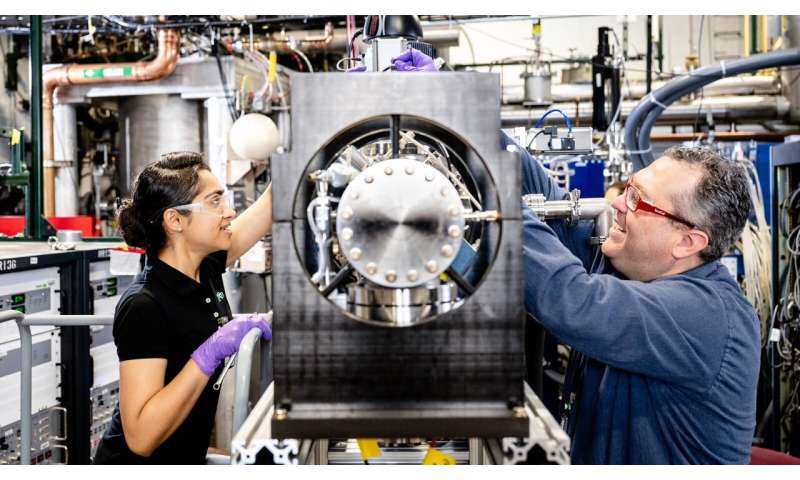Laboratory uses heavy ions to quickly and safely produce degradation in nuclear materials

The AMIS beamline uses the lowest high-energy beams to displace oodles of atoms, making the study of nuclear materials safer and more efficient.
ATLAS—the Argonne Tandem Linac Accelerator System—can do even more "heavy lifting" for physics and nuclear science than previously thought.
Located at the U.S. Department of Energy's (DOE) Argonne National Laboratory, the DOE Office of Science user facility is well known among physicists for its ability to study nuclei—the core of matter and the fuel of stars. Now, its high energies are also rapidly providing new information about what happens to a material inside a nuclear reactor.
With the recent commissioning of the ATLAS Material Irradiation Station (AMIS), Argonne scientists are using some of the accelerator's lowest energies to deliver heavy ions and degrade the properties of nuclear materials without activating them.
In a nutshell, the scientists can affect the properties of the materials without the radioactivity that can be associated with irradiation in a reactor. These damage studies are essential to development of new materials for nuclear reactors, which can produce significant amounts of reliable electricity without harmful carbon emissions.
"Heavy ion beams are a gift," said Jerry Nolen, an Argonne Distinguished Fellow and physicist who was one of the first scientists to propose developing AMIS more than a decade ago. He compares the heavy ion beams at AMIS to a virtual bowling ball plowing through atomic pins. "You cannot damage anything quicker than this."
Abdellatif Yacout, the senior nuclear engineer whose materials research group led the project and developed the materials test station, is leading initial experiments at AMIS sponsored by different DOE programs. The beamline design, construction and commissioning were led by accelerator physicist Brahim Mustapha.
The heavy ion beams accelerated by ATLAS to AMIS instantly cause big properties degradation in target materials exposed to those beams. This means there is a huge number of displacements per atom (DPA) when target materials are irradiated or hit with a beam. Scientists like Yacout are interested in a multitude of DPAs by iron, xenon, uranium and other elements frequently associated with nuclear energy production because it is important to understand how the degradation those elements cause in materials will compare to materials' exposure to neutrons inside the intense environment of a nuclear reactor.
At AMIS, this degradation occurs very quickly without activating the irradiated materials (that means the bombarded material doesn't become radioactive). As a result, the process is safer for everyone and the materials don't require special handling or operating procedures when they are used for later analysis. Scientists can produce this data in hours instead of years, minus the risk.
Yacout explains that all the thermal reactors in the United States (currently upwards of 90) produce neutron damage or degradation of material's properties at an approximate rate of 10 DPAs or less per year. That is not a lot. It limits the ability to do complex research into advanced nuclear fuels and materials because it takes a long time to gather valuable data.
"The AMIS facility will produce hundreds or even thousands of DPAs," said Yacout, who also manages the Fuel Development and Qualification department within Argonne's Chemical and Fuel Cycle Technologies division. "Instead of getting this damage in years when you put a material in a nuclear reactor, you will get the same damage in a matter of hours or days when you irradiate it at the AMIS beamline, including nuclear fuel materials."
During the years they explored development of this process, Yacout and his team would set up equipment to conduct brief experiments near the beginning of the ATLAS beamline, far ahead of where ATLAS delivers heavy ions at energies approaching (or even surpassing) the Coulomb barrier. Their efforts were sometimes interruptive to other experiments. They also encountered lengthy preparation and loading of samples, the ensuring of vacuum and disassembly of the experiment when it was over. That all took time that the scientists would have rather used to conduct experiments.
"AMIS is about convenience and allocating more irradiation time so more users in the nuclear energy field have access to these unique high energy heavy ion beams that they wouldn't otherwise be able to access," said Yacout. "AMIS reduces unproductive time and opens the door to more studies."
An already-planned upgrade of the facility will provide opportunities for multiple users to operate AMIS and other ATLAS capabilities in parallel.
Provided by Argonne National Laboratory